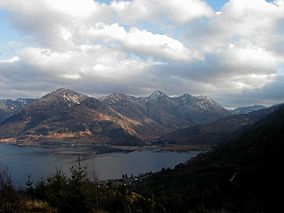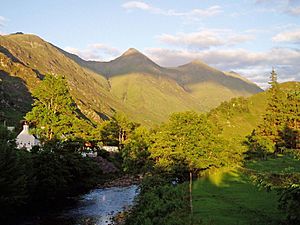Kintail facts for kids
Quick facts for kids Kintail National Scenic Area |
|
|---|---|

Five Sisters of Kintail from Màm Ratagan
|
|
| Location | Highland, Scotland |
| Area | 171 km2 (66 sq mi) |
| Established | 1981 |
| Governing body | NatureScot |
Kintail (which means "Head of the Tide" in Scottish Gaelic) is a beautiful area of mountains in the Northwest Highlands of Scotland. It's found in the Highland Council area. This special place includes mountains north of Glen Shiel and the A87 road. It stretches between the ends of Loch Duich and Loch Cluanie.
Kintail is also part of the Kintail National Scenic Area. Scotland has forty of these areas. They are chosen because they have amazing scenery. This helps protect them from building projects that might spoil their natural beauty. The Kintail National Scenic Area includes the mountains of Kintail itself. It also covers the southern side of Glen Shiel and goes west to Dornie. This protected area is huge, covering over 17,000 hectares of land and sea. It shows off the stunning views of the west highlands. Here, tall mountains rise sharply from narrow valleys and the sea.
The main village in Kintail is Morvich. It's located north-west of the mountains, close to the A87 road. Morvich is home to the Kintail Mountain Rescue Team. It also has a campsite run by The Caravan Club.
Contents
Mountains of Kintail
The hills north-east of Glen Shiel are famous. They are known as the Five Sisters Of Kintail. In Gaelic, this is Còig Peathraichean Chinn Tàile. These five mountains form a long, high ridge. It's about 8 kilometers (5 miles) long. The ridge rises steeply from Glen Shiel, reaching over 1,000 meters (3,000 feet) high.
The Legend of the Five Sisters
There's a cool legend about these mountains. It says the five sisters were the oldest of seven. The two youngest sisters fell in love with Irish princes. These princes washed ashore during a storm. Their father said the younger sisters could only marry if the older ones did too. So, the princes promised to send their five brothers from Ireland. But the princes never came back. The five sisters kept waiting. Eventually, they turned into mountains. This way, they could wait forever!
The five pointed peaks are easy to spot. Their names are Sgùrr na Ciste Duibhe, Sgùrr na Càrnach, Sgùrr Fhuaran, Sgùrr nan Saighead, and Sgurr na Moraich. They are a popular place for hillwalking. Three of the Five Sisters are over 3,000 feet tall. This means they are classified as full Munros. The other two are slightly smaller "Munro tops."
The Brothers of Kintail
The ridge of the Five Sisters continues to the east. Here, you'll find three more Munros. These are Sgùrr a' Bhealaich Dheirg, Sàileag, and Aonach Meadhoin. People often call these the Brothers of Kintail. Another important mountain in the area is Beinn Fhada (also known as Ben Attow).
Who Owns Kintail?
Most of Kintail belongs to the National Trust for Scotland (NTS). The Trust's Kintail and Morvich estate covers about 74 square kilometers (28 square miles). It includes the amazing Falls of Glomach. This is one of the highest waterfalls in Great Britain.
The NTS bought this land in 1944. Percy Unna, who was president of the Scottish Mountaineering Club, helped buy it. He also helped the Trust get Glen Coe. The NTS runs an outdoor education center in Morvich. It provides places to stay for groups. For example, school groups can come here for field studies and outdoor activities.
Wildlife and Nature
Kintail is home to many interesting animals. You might see golden eagles flying high above. Merlins and black-throated divers also live here. Otters are quite common in the waters. Pine martens can be found in the wooded areas. On the lower mountain slopes, you might spot red deer.
Kintail also has a herd of feral goats. These goats are thought to be descendants of goats brought to Britain around 3000 BCE. That was a very long time ago, by neolithic farmers! Because they are not native to the area, the National Trust for Scotland is thinking about reducing their numbers. This would help the native plants and trees grow better.
Historical Landmarks
There's a very old standing stone near Shiel Bridge. It's called Cill Fhearchair. This stone is 1.75 meters (about 5.7 feet) tall and is 2,000 years old. It stands in a burial ground.
Another important spot is "Prince Charlie's Stone." This is a large rock on the steep slopes of Sgùrr na Ciste Duibhe. Charles Edward Stuart, also known as Bonnie Prince Charlie, hid here in the summer of 1746. He was hiding from government troops. At that time, there was a huge reward of £30,000 for his capture. He was on the run after the Battle of Culloden.



